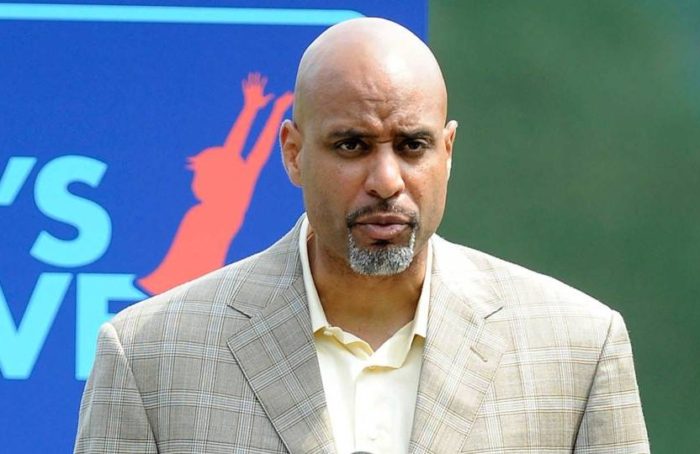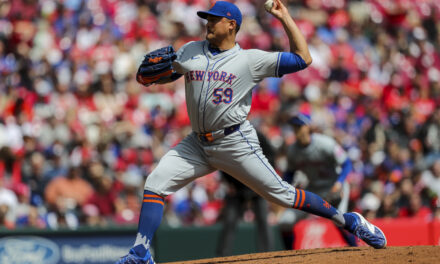
Let’s try something different. The lockout has now reached its 73rd day, and despite commissioner Rob Manfred’s optimistic tone on February 10, the two sides are still not close to a deal that will allow baseball to be played. Saturday’s meeting did not seem to move the needle, but could there be some hope on the horizon? Here’s the positive spin.
The doom and gloom projections are everywhere. Spring training will be delayed, and the start (and length) of the regular season is also in question. Here are a few reasons to look at the glass as half full, which not many are doing right now.
The Competitive Balance Tax
The most contentious issue of them all may represent the best source of positivity. On Saturday, the owners made a very small move in the players’ direction, offering to raise the threshold at which teams would begin paying the tax, and lowering the tax levels from their previous proposals. From an article by Bob Nightingale of USA Today:
Major League Baseball slightly enhanced their proposals on several economic issues Saturday. MLB increased their luxury tax by $2 million, starting at $214 million for the first two years, $216 million in 2024, $218 million in 2025 and $222 million in 2026. They also lowered the penalties for exceeding the luxury tax. Teams will no longer lose draft picks unless their payroll exceeds $234 million, a figure that only four teams have ever eclipsed.
Why could this be good news for a new Collective Bargaining Agreement? The owners moved. On a core economic issue, that many felt was cast in stone in the owners’ minds, there was a budge. This means that MLB is willing to negotiate on this topic. There is still a substantial gap to bridge, but movement on a topic previously considered out of bounds represents a slight thawing of the ice, something on which the negotiations can build.
The Minimum Salary
In MLB’s proposal on Saturday, they slightly increased their offer on the minimum salary, from $600,000 in their previous offer to $615,000 for first-year players, $650,000 for second-year players, and $725,000 for players with more than two years of service but not eligible for arbitration. This does not match the players’ request, but again, there was movement that likely will not stop with the current offer. Considering that approximately 68% of MLB players earn less than $1 million per year (Associated Press), movement in this area is significant and will impact a significant percentage of the league.
The Bonus Pool
A bonus pool for pre-arbitration eligible players is a concept that sides have agreed to for the new CBA. The funding of that bonus pool currently stands at $100 million requested by the players and $15 million in the owners’ most recent offer. The gap has shrunk from $95 million to $85 million. Both sides are inching toward each other. They will have to move more quickly, but once the concept is in place, the dollars essentially amount to haggling rather than philosophical differences. This one should able to be closed as a function of increased revenue coming from expanded playoffs (the playoff teams will expand, by how much is yet to be determined).
Service Time Manipulation
Keeping players in the minor leagues longer so they remain under team control for an extra year is something that both sides seem to want to change. That’s the good news. From Nightingale’s article:
MLB has proposed that a six-person joint committee would develop a WAR statistic to increase the pay for the top young players, while giving $1 million bonuses to non-arbitration eligible players who win the MVP or Cy Young; $500,000 to second-place finishes and Rookie of the Year winners; $250,00 to third-place finishes and runner-up Rookies of the Year, and $100,000 finishing fourth or fifth in the MVP/Cy Young balloting and a third-place finish for Rookie of the Year.
Teams also would receive two extra draft picks if their rookies finish in the top three in the MVP, Cy Young and Rookie of the Year races as an incentive for teams to not manipulate service time.
They’re probably fairly close on this one.
Draft Lottery
MLB and the MLBPA agree that teams should be discouraged from “tanking” to get prime draft picks. The draft lottery is used in other sports, and the sides have agreed in principle on using it in baseball. The owners want three teams in the lottery, the players want eight. Let’s go folks, settle on five or six and let’s put this one in the win column.
Universal DH
The two sides have agreed on having a DH in both leagues. This will create or preserve jobs for a few more established, and often high-salaried, players. The union has pointed to the replacing of established players with younger ones for financial benefit as a concern. The universal DH will not solve this issue, but can serve as a step in the right direction.
The Calendar
Manfred has said that missing games will be “disastrous.” The players probably don’t want to lose paychecks (as noted 68% of players earn less than $1 million), despite claims of a “war chest” of funds to be used in work stoppages. The reality is that there are eight days until the “soft” deadline for a new CBA. If the lockout ends by February 21, camps can open on February 28, exhibition games can begin around March 10, and players should be ready for a full season beginning on March 31. A lot or a little can happen in eight days. Often, movement accelerates when a deadline gets close. A sense of pressure on both sides can work in favor of a new agreement.
A sticky point in the negotiations will be revenue sharing, under which teams share 48% of their take on tickets sold, concessions, and other local revenues. The players want to reduce the amount of revenue shared by $30 million, and the owners are adamant that revenue sharing must remain the same. It seems odd that the players hold onto the idea that there should be greater competition in baseball, yet want to take away a source of income from lower-revenue teams. The players feel that shared revenue is not always put back into the team on the field, and they’re probably right. Perhaps greater transparency and accountability are the answer, rather than less revenue sharing.
Is this an overly positive look at the current labor dispute? Maybe it is. However, Saturday’s session was intended to show movement in some areas to inspire further discussions. The movement was slight, but perhaps symbolic. The players are supposed to reply with an offer in a few days.
MLB and the MLBPA may not get to a deal by February 21. If they don’t, it’s on them. The fans’ backlash and any associated lost revenues will be shared accountability. They have a chance to get this done and minimize the impact on the 2022 season. Whether they do or not is their next test. They have not done well to date, maybe Saturday’s meeting was the beginning of a new and improved trend.















